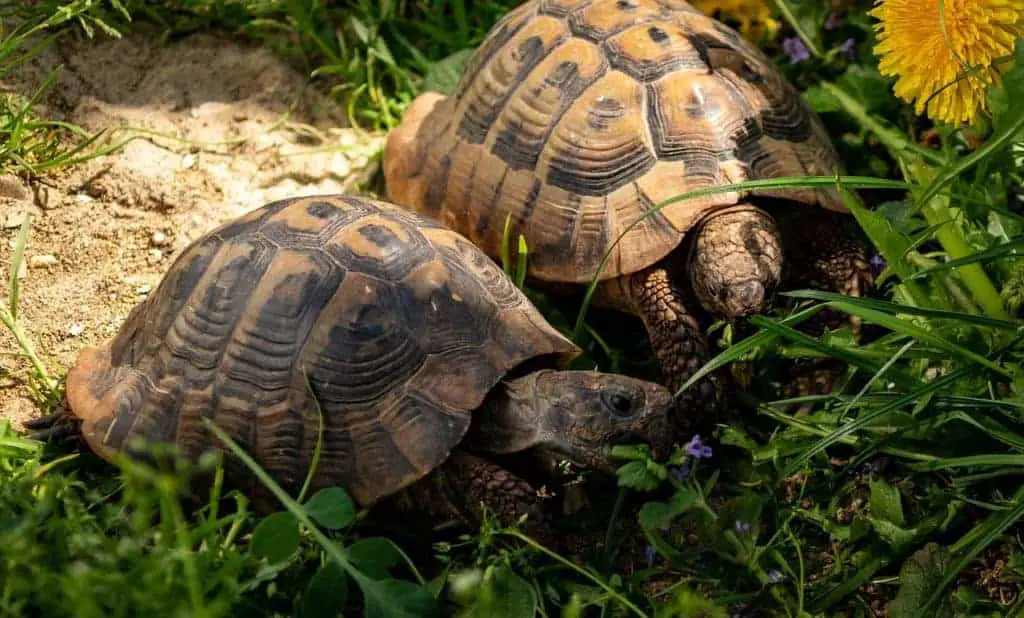
There are a million reasons to love tortoises; they have cute faces, have a temperament that (usually) makes them far more agreeable pets than other reptiles such as snakes or lizards (who might be tempted to take a nip out of their owners once in a while), and they are relatively easy to house and feed; eating a herbivorous diet from either the store or backyard. In most cases they also do not require an enclosure with its own micro climate.
Problems sometimes arise with some species that grow to be too large and demanding on their owners. Something like a Sulcata tortoise for example may start out very small, but will grow into a giant grazing machine before long, requiring a large amount of grassland to sustain itself.

A species where this is far less of an issue is the Hermann’s tortoise. Native to the mediterranean coasts of southern Europe, this species is relatively hardy and does not reach a size greater than about 10 to 12 inches (25-30cm) in length.
If you are serious about keeping a tortoise as a pet and you’re already familiar with the idiosyncrasies associated with tortoises in general; such as longevity and, oftentimes at least, the need to hibernate, then choosing a Hermanns tortoise would be a wise choice.
That’s not to say a Hermann’s tortoise is a lazy person’s pet however, there is much to learn about keeping one, and they still require a great deal of care. So please read on before making a decision to buy.
If you want an overview of some of the basic equipment you’ll need to care for a Hermann’s tortoise check out our recommended tortoise care products.
Hermann’s Tortoises: The Basics
Just as a salesperson needs to know their customer, or a performer needs to know their audience; as the owner of a pet, you need to know all about your animal if your relationship with them and understanding of their needs is to lead to a healthy and happy existence for them.
Native Habitat
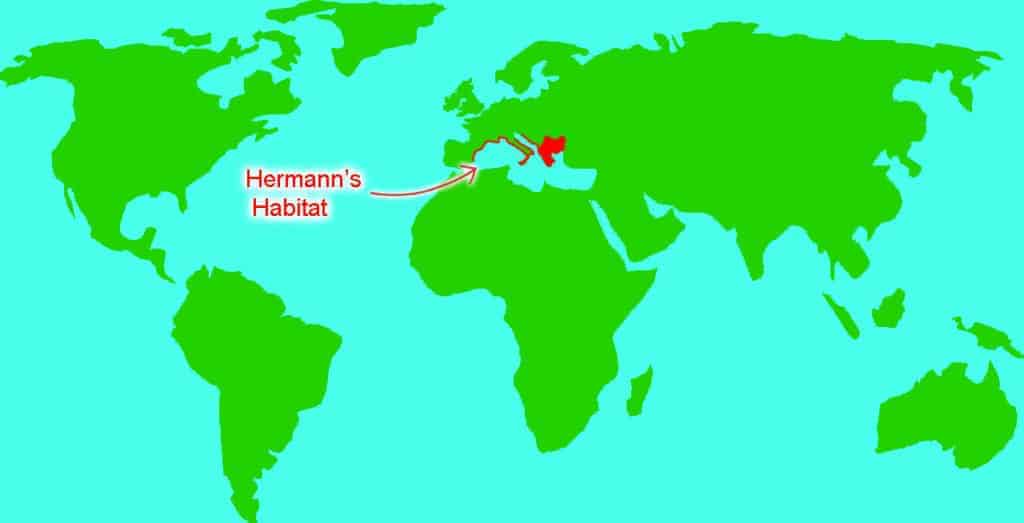
Along with Mediterranean Spur Thigh tortoises (not to be confused with African Spur tortoises), and Marginated Tortoises, Hermann’s tortoises are endemic to southern Europe in the Mediterranean region, between western Turkey and eastern Spain. There are two sub species; the eastern variety native to the region from the west cost of Italy to Spain, and the western variety, native to the region from the east coast of Italy to western Turkey.
To further complicate things, there is an additional ‘in between’ sub species scientifically known as T. h. hercegovinensis or ‘Dalmation Tortoise’ which hails from the Balkan region. This particular variety shares traits of both the eastern and western varieties of Hermann’s tortoise, but with a few subtle differences. Incidentally I believe my own tortoise to be of this subspecies, given the country of origin on their Article 10 certificate is Croatia.
Regardless of the sub species the basic habitat of all Hermann’s tortoises is the same; semi-arid grasslands.
Size and Weight
Hermann’s tortoises are physically similar to many other tortoises species, but more so in particular (and unsurprisingly) to other mediterranean species.
Hermann’s tortoises are a medium sized breed, with hatchlings being up 1.5” (3.5cm) long, which is fairly typical among most breeds.
Fully grown females may reach 10 to 12 inches (25-30cm) in length, while males tend to be smaller. Likewise a fully grown female can reach a weight of around 8 pounds (3.5kg). Typically however, most specimens will not reach a size or weight as advanced as this.
Coloration and Shell Pattern
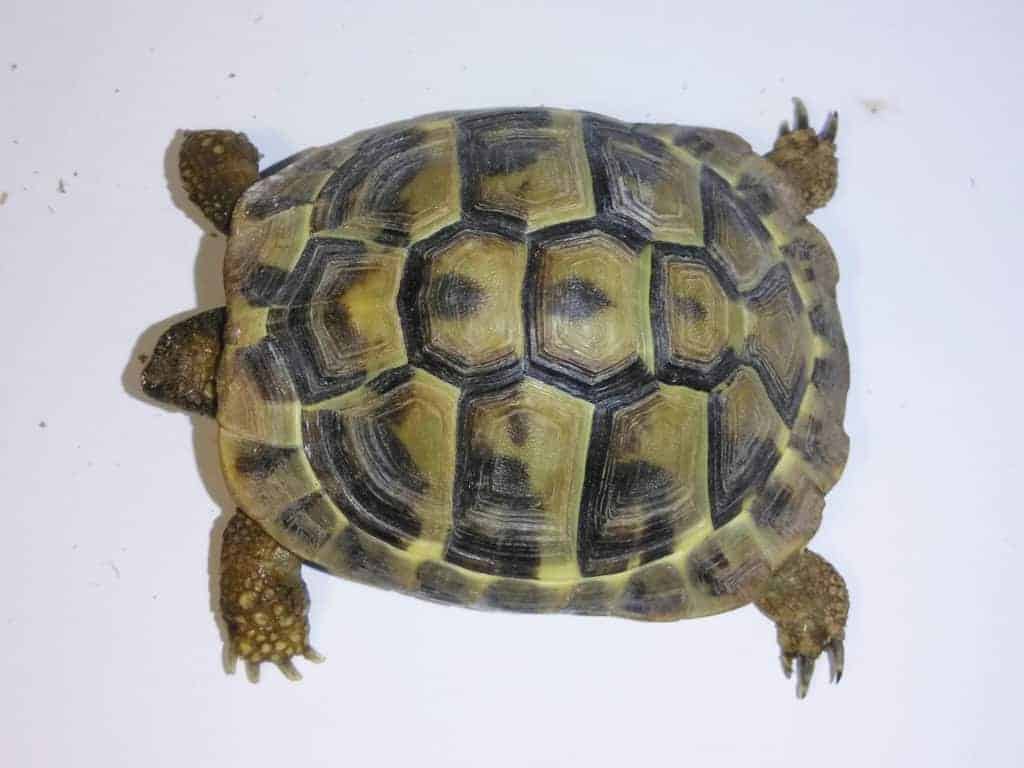
The upper part of a tortoise’s shell is known as the carapace, which in the case of a Hermann’s tortoise, can vary between shades of organic yellows, greens and browns, while the underbelly (plastron) tends to be a faint yellow or bone color with prominent dark brown or black markings.
The exposed areas of skin on the head and legs are again an earthy green or yellow color. There are usually scaly areas on the legs, probably to protect the limbs when burrowing.
A healthy Hermann’s tortoise will have a relatively smooth shell, which appears domed when viewed from the side. Like all tortoises the shell is an integral part of the tortoise’s skeleton, with the outer plates of the shell (called scutes) being an extension of the ribs and spine.
Senses
There is some debate about how well tortoises are able to hear, however they certainly possess good eyesight which enables them to track down food which is safe to eat. Hermann’s tortoises are no exception, and like all other species they have a sharp beak rather than teeth to slice through their food.
You will seldom hear a tortoise making any kind of sound vocally, however males may grunt and squeak during courting and mating with a female.
Along with their strong eyesight, tortoises also have a good sense of smell. Used in combination these two senses again allow a tortoise to track down food that is safe to consume.
Limbs
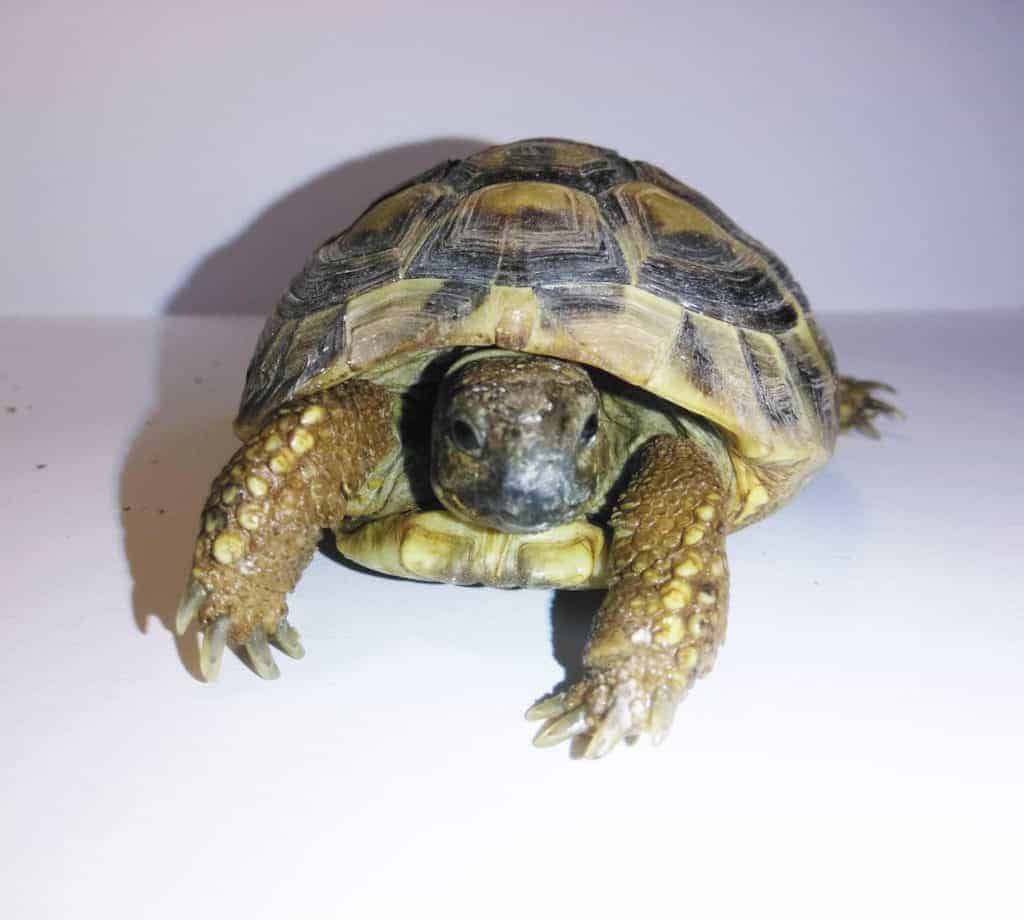
I sometimes think it looks like hard work when I see my tortoise hauling himself about the place, almost as though the shell is weighing him down. Perhaps for this reason tortoise legs have evolved to be a strong as possible in order to shift around such a heavy payload.
The rear legs in particular resemble those of an elephant, so clearly there is some anatomical similarity among tortoises and other heavy animals.
Distinguishing Between Male and Female Hermann’s Tortoises
One of the trickiest things for the untrained eye to do is determine the sex of a tortoise. We know that females are generally larger than males, but this isn’t particularly helpful given that there are always exceptions, and besides, unless you have more than one tortoise, you won’t have a point of reference.
The simplest way to get a reasonably accurate idea of the sex is by observing the length of the tail; in males it tends to be far longer, long enough to wrap around slightly, whereas a female’s tail is more likely to be stubby.
You’re only likely to need to know for sure whether your tortoise is male or female if you plan to keep two tortoises together, otherwise it’s a fairly inconsequential detail that won’t affect your husbandry.
Internal Anatomy
Though they look unusual on the outside, tortoises feature the same basic internal systems as other vertebrates, including humans. This includes a digestive tract and a respiratory system much like our own.
There are of course subtle differences, such as a different musculature structure to facilitate the inhalation and exhalation of air; because unlike us, tortoises cannot flex and expand their rib cages to allow air to expand and fill their lungs.
It’s also interesting to note that tortoises have heart made up of 3 rather than 4 chambers. This, as you might imagine, is not as effective at circulating blood throughout the body, which goes a long way towards explaining why tortoises prefer to take life at a somewhat more leisurely pace than we do, and why they quickly tire after short periods of exertion.
Reproductive System
If the number of videos on Youtube of tortoises getting down to business is anything to go by, it’s fair to say that the reproductive systems of tortoises are of particular interest to many people!
Like other reptiles, birds, and some mammals, tortoises possess a cloaca; a multi-purpose orifice that serves as both the point of excretion of urine and solid waste material, as well as the reproductive opening.
Male tortoises do have a phallus, although it is rarely seen as it is stored inside the body, only emerging at the point of mating when the male will implant sperm in the female’s cloaca.
Females produce eggs in much the same way as birds and other reptiles, passing them through their cloaca when they are ready.
Hermann’s Tortoise Behavior
Just as birds are adapted for flight, and penguins are adapted to low temperatures, Hermann’s tortoises have particular biological and behavioural adaptions that allow them to thrive in their natural habitat.
It’s important to have an understanding of these adaptions so that you can do your best to simulate the correct environment for your pet Hermann’s to thrive in.
Growth and Lifespan
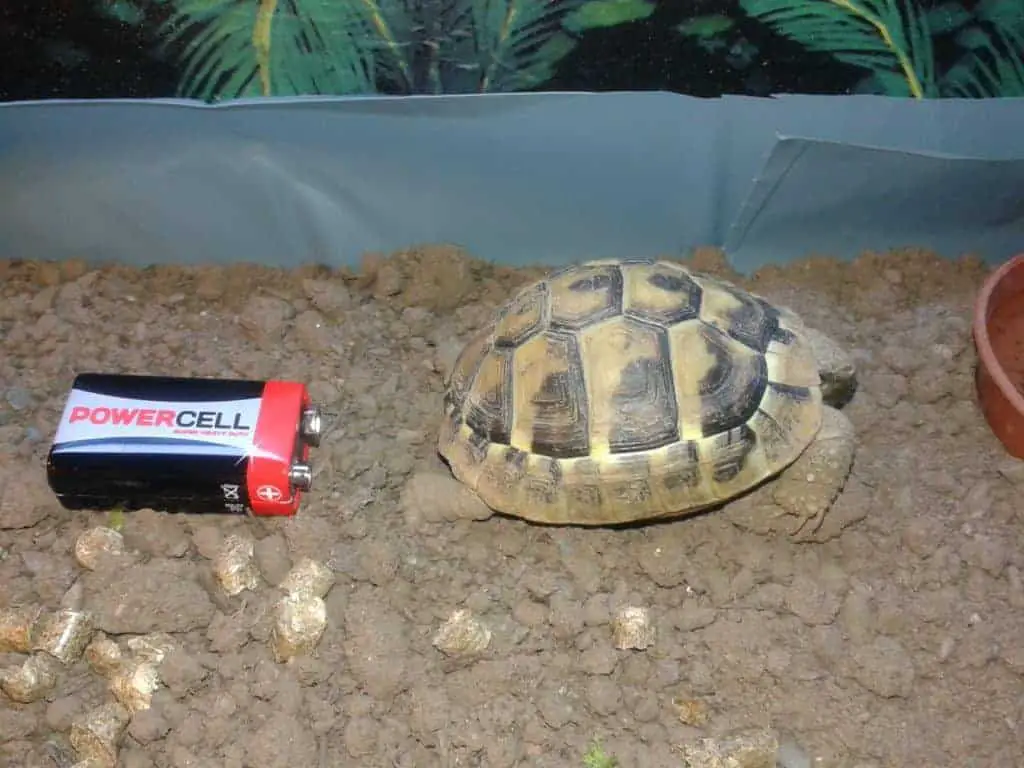
Hermann’s tortoises are slower growing than some of their larger cousins, typically taking about a decade to reach maturity and their fully grown size. Again, this can be up to 12” (30cm) but around 10” (25cm) is much more typical.
It’s important not to try an expidite the growth of your tortoise in any way (by feeding them meat for example) because this can result in issues such as the body growing too quickly and outgrowing the shell, leading to all sorts of health issues. Indeed, one of the key reasons behind hibernation is to slow down the growth process of the tortoise.
A Hermann’s tortoise will live for anything between 50 and 75 years if properly cared for, although in the wild many do not reach such an advanced age due to predation and illness.
Skin and Scute Shedding
A lesser known process exhibited by tortoises is the continual shedding of their skin and shell scutes. Unlike a reptile such as a snake that sheds all of its skin in one go, tortoises (much like ourselves in many ways) continually shed their skin such that it isn’t particularly noticeable.
I haven’t personally witnessed the shedding of shell scutes, being a less regular practice than skin shedding, but it does none the less happen.
Metabolism and Digestion
Like other reptiles, tortoises are cold blooded animals, meaning their internal temperature is entirely dependent upon the temperature of their environment; unlike mammals who are able to self regulate their internal temperature unless ambient temperatures are dangerously high or low.
In any case, this means a tortoise’s metabolism will be quicker when the air is warmer, while at cold temperatures their bodily functions slow right down. Both states serve their purpose, for example at warmer temperatures they are able to digest food more effectively, while a consistently low temperature provides the right conditions for hibernation.
Are Hermann’s Tortoises Intelligent?
Tortoises can be described as many things; slow, lumbering, or funny. One thing you won’t hear in the same sentence as the word tortoise, however, is ‘intelligent’. Their brains are very small (around one percent of their total body mass).
Nonetheless I believe they are intelligent enough to recognise their owners, certainly when it comes to feeding time and they can’t make their way over to you fast enough!
Foraging and Feeding Habits
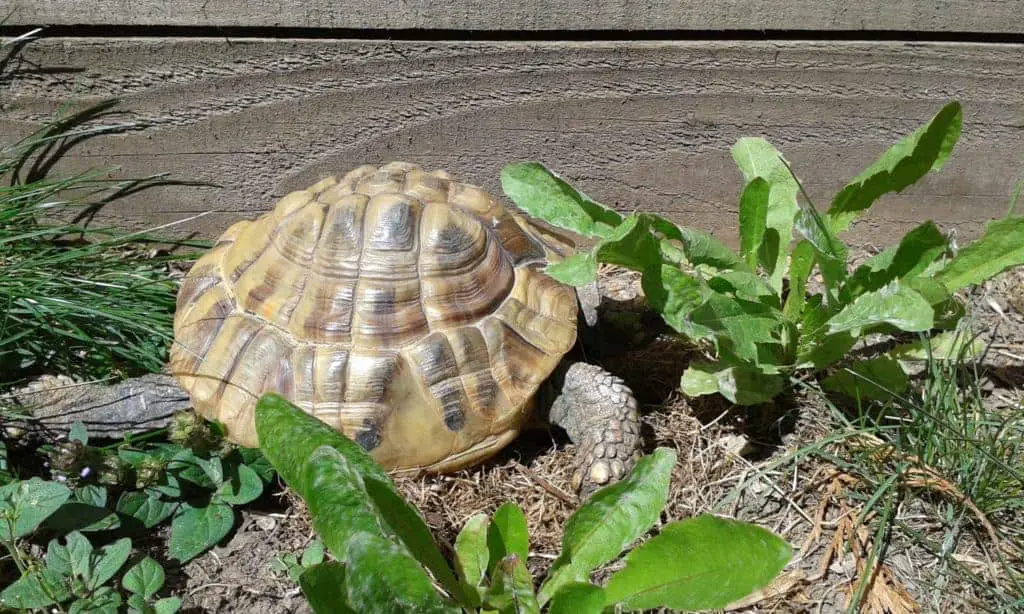
Like most tortoises, Hermann’s tortoises are herbivorous (although I have witnessed one consume a slug on more than one occasion). In their natural habitat Hermann’s tortoises will forage for food throughout the day, however, they prefer to eat early in the day when the air is cooler. Presumably this corresponds with digestion taking place slightly later when the air is warmer. It also means they can keep out of the heat by retreating to a sheltered area, away from the midday sun with a belly full of food to keep them going.
When temperatures drop later in the afternoon, tortoises may go for a second round of foraging, although they won’t likely eat as much as food will be digested more slowly in the lower nighttime temperature.
Like other hibernating species of tortoise, Hermann’s tortoises will choose to hibernate when temperatures consistently drop below a certain level (typically 2°F-10°C or 35.6°-50°F).
In the wild they will find a safe burrow or crevice to sleep in throughout the winter, however they are more than able to wake temporarily for a time if the temperature reaches an uncharacteristically high figure for the time of year.
Defensive Behaviour
Tortoises aren’t naturally aggressive animals, and rely primarily on being inconspicuous to try and avoid confrontation with predators. This involves taking advantage of their natural camouflage and by burrowing.
Mature specimens have the defence of a hard shell that is hard to break for most small predatory mammals, and of course the tortoise will retract its limbs and head into its shell when immediate danger is detected.
Younger tortoises don’t have a fully hardened shell however, so it’s even more important for them to keep well out of sight unless foraging.
Selecting Your Tortoise

Buying your Hermann’s tortoise from a reputable source is of course important for many reasons, not least of which is that they will know whether the tortoises they are selling are in good health or not.
Nonetheless it pays to personally have a decent understanding of what to look for when selecting a healthy tortoise so you can double check that you are investing in a healthy specimen. Besides health; the age, sex and provenance of the tortoise will all have a bearing on your ability to raise it successfully.
Health
A visual inspection will provide many clues as to the health of a tortoise, so knowing what to look for is important:
- Check the condition of the shell. This should be dome shaped without lumps and peaks (known as pyramidding), which indicates errors with the diet the tortoise has been fed or the environment they have been kept in.
- Check the skin for injuries – small cuts that are barely noticeable may heal without issue but any large open wounds are unlikely to heal without complications developing, and will therefore require significant veterinary attention. This will of course be expensive
- Check the eyes, ears and nostrils for mucus or discharge which could be signs of infection
- Check the cloaca (back passage). This should be clean and clear of feces, which if present could indicate that an infection is also present
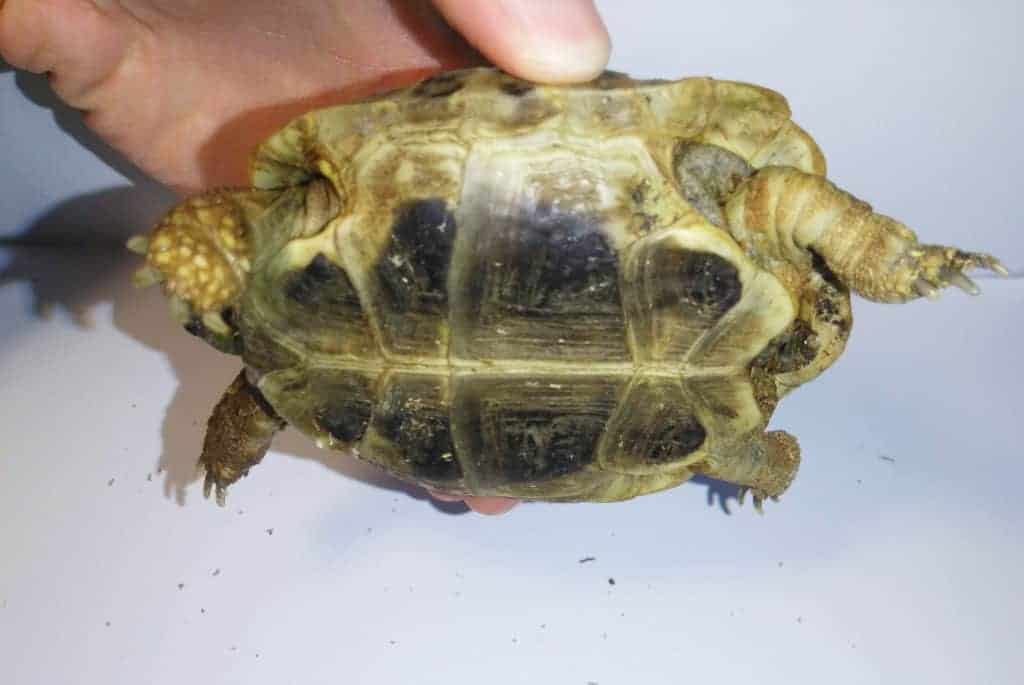
Age
It’s advisable to steer clear of buying a hatchling tortoise (ie. one that is less than a few months old) simply because tortoises of this age are very fragile indeed, and therefore difficult for all but the most well equipped and experienced of owners to manage safely.
To be most certain that your tortoise is sufficiently strong when you take them on, selecting a specimen that is at least a year old is a safe bet, as they will be better adapted to being put in a new environment that does not need to be quite so stringently managed in terms of temperature and humidity.
Sex
Determining the sex of your prospective tortoise isn’t particularly important so long as they are to be kept as a solitary pet. Females may suffer from health problems arising from their reproductive systems, and although less likely if she is kept in isolation, a female can still produce unfertilised eggs. Keeping a male obviously doesn’t present any of the problems that may or not be associated with this happening.
Clearly if you plan to keep more than one tortoise you’ll need to know the sex of each, or else you might find yourself with some unexpected additions to look after!
Where to Aquire Your Tortoise
You can acquire a Hermann’s tortoise via several means, although not all are legitimate. Of the ways that are, each has their pros and cons, but in the end the health of the tortoise must be the deciding factor over whether you choose to take him or her on as a pet.
You can read up in greater depth about where we advise you do and don’t buy your tortoise from here.
Pet Stores
Perhaps the most obvious place to source your tortoise from, pet stores offer the advantage of having everything you need to get started in your pursuit of tortoise husbandry, as well as full visibility of all the tortoises on offer. They will also usually allow you to make a full visual inspection of a tortoise or tortoises so that you can make a judgement over which you think will most likely thrive in your care.
The major downside to a pet store is the increased mark-up they must put on their stock in order to keep the lights on.
If you choose to buy from a breeder you’ll usually find they are far cheaper given that they usually breed tortoises as more of a side business/hobby, and are therefore less driven to maximise profits than a pet store.
Breeders
Breeders are considered to be individuals who are passionate about tortoises and who will provide you with the best advice and support. As mentioned they typically sell their tortoises at less of a mark-up than pet stores, and typically also offer their ‘after sales’ services as a source of advice and support after you have purchased your tortoise.
The only real drawback to using a breeder is that you likely won’t be able to get any hands on inspection of your pet in advance of arranging to meet and make the transaction.
Although this sounds questionable, there is in fact a very good reason for it; most breeders do not like to reveal the location of their home address for fear that they may fall victim to theft of their animals. None the less, most will gladly provide you with as much detail as you require in advance of your purchase including providing photographs and details of the animal’s provenance.
The Cost of Buying and Owning a Hermann’s Tortoise

One of the appealing things about tortoises is that they are a relatively low cost pet to keep. Unlike dogs or cats that require specialist shop bought foods, tortoises can happily graze on the natural weeds and grasses in a (healthy and verdant) backyard.
Providing you do a good job looking after them they also don’t require specialist grooming, accessories, and costly inoculations in order to stay healthy. Keeping things as natural as possible is key with tortoises, which happily enough, also happens to mean relatively little ongoing expense.
That being said however, there are some pretty hefty upfront costs to consider; namely the cost of the tortoise, and the cost of the enclosure/tortoise table you will keep them in for the first few years of their life. It’s also important to keep in mind unforeseen veterinary costs that might crop up, and, if you deem it necessary, you’ll also need to budget for the cost of insurance.
A hatchling Hermann’s tortoise can cost anything from between $100 – $200 (£75 – £150) , which is fairly reasonable compared to what you might pay for something like a dog. Adult specimens may be more expensive, although determining their provenance and state of health is more important than with juveniles and hatchlings.
Given the relatively cheap cost of purchasing the tortoise itself, it may or may not be surprising to learn that commercially available tortoise enclosures and tortoise tables often cost more than you might pay for your tortoise; with some enclosures costing upwards of ($200) £150. Still, the good news is this is a one of payment and will serve your tortoise well for as long as they need it. Read our full guide to tortoise tables here.
The costs don’t end there of course; other initial expenses include lighting, a thermometer, and interior furnishings which you can expect to spend about hundred bucks on, give or take.
Note in particular that light bulbs will need to be replaced once or twice a year as their continual operation means they will blow more regularly than other lamps in your home. UV strip lamps are the most expensive of these at upwards of $20, so this isn’t an insignificant cost.
Food
Upfront costs aside, the most obvious recurring cost of keeping a Hermann’s tortoise the cost of food. Ideally of course there would be no cost to this at all, if you were able to allow your tortoise to graze on the verdant pastures of your back yard all year long, with ample variety of weeds and flowers to gorge on.
The reality for many people, especially with a juvenile tortoise, is that you will need to bring the food to them, which more often than not involves providing shop bought salad leaves and vegetables, in addition to any suitable plants you are able to pick from your yard. Aim to budget about $5 per week on food; this will provide enough to cover a full shop bought diet if required.
Other Consumables
Besides food and light bulbs an indoor tortoise enclosure also includes a substrate base (usually sterile soil mixed with sand or straw pellets) which must be fully replaced every 2 to 3 weeks. This is a fairly significant cost and may be $100 per year or more given how much of the stuff you will get through. You may also use other items such as tissues/paper towels for cleaning out your enclosure, which might cost another $30 per year.
Hermann’s tortoises also require specific sources of calcium other than that found in food to ensure healthy growth and development of their shell. Traditionally a cuttlefish bone (cuttlebone) has been the source of choice. These cost a few bucks and will probably last a couple of years before they must be replaced given the infrequency with which the tortoise will nibble at them.
To supplement their intake of calcium, powdered calcium products are available, some of which contain various ingredients that the manufacturers claim are beneficial to health. Personally I like to keep things simple and only use a pure calcium carbonate powder (effectively just a ground up cuttlebone) because this is the form from which tortoises benefit the most.
Vet Bills
One of the great things about tortoises is that if properly cared for they are unlikely to fall ill, and unlike some other pets they don’t require routine check-ups for any reason. The only thing I have ever had to take my tortoise to the vet for is to get his beak and claws trimmed on a couple of occasions. Although even this can be negated if you have a scratching stone and something like a cuttlebone or tortoise block to abrade the beak.
None the less, the unexpected can, and invariably will, at some point happen, so it’s important to have some money kept aside for vet bills for more serious ailments that require more expensive treatment. This can vary wildly of course, but keeping $500 in the pot is probably a safe amount to cover most eventualities.
Habitat
When keeping a Hermann’s tortoise in captivity the ultimate aim is to try and replicate the climate and environment of their natural habitat. In an ideal world you will keep your tortoise outdoors for as much of the year as possible, although depending on whereabouts in the world you live this may not always be viable.
Although Hermann’s tortoises can tolerate lower temperatures, and indeed they require cooler night time temperatures in order to thrive, for around half of the year they require daytime ambient temperatures of around 26-30 degrees Celsius (79 -86 Fahrenheit).
Furthermore sunlight should be able to heat certain ground spots within the enclosure to at least 37 degrees Celcius (100 degrees Fahrenheit). In climates such as northern Europe this isn’t always going to be the case, so to supplement, you can either plan to bring your tortoise indoors on cooler days or portions of the year or add a heating element to your outdoor enclosure. Some people also have success with a ‘greenhouse’ type structure to retain the sun’s heat for longer.
High levels of humidity can also pose a problem to Hermann’s tortoises, being as they are, not adapted to very humid conditions. If they are left outdoors throughout long rainy months then they risk developing a range of health issues, from respiratory problems, to shell rot.
Even if you determine that your local climate is unsuitable for keeping your tortoise outdoors even on a semi-permanent basis, you should still aim to allow them some supervised time outdoors on the occasions when it is warm and sunny, so that they can benefit from natural sunlight.
Getting the Temperature Right
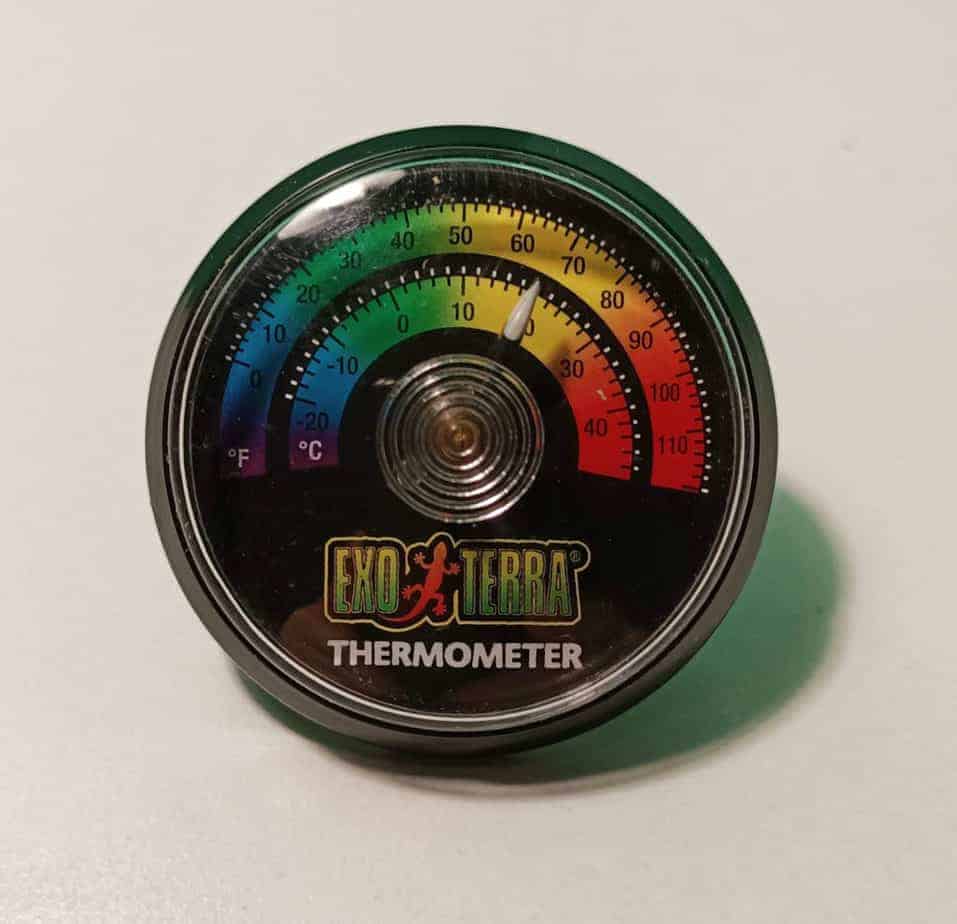
Hermann’s tortoises, like all reptiles, are cold blooded animals. This means that they rely on external sources of heat to regulate their temperature, and their metabolic rate is dependent on the temperature in their environment.
So critical in fact is maintaining the correct temperature for your tortoise, that if it is not correct you could find you have a sickly tortoise blighted by infection, rather than one who thrives and enjoys life
Hermann’s tortoises need the air to be pretty warm by day (around 30-33 degrees Celsius or 86 to 91 degrees Fahrenheit) to replicate the sub-tropical conditions of their homeland, and around room temperature (21-23 degrees Celsius or 70-74 degrees Fahrenheit ) at night. In addition, tortoises also like to bask in even warmer temperatures at certain points during the day, requiring a hot spot (whether a space on the ground heated by the sun, or a heat lamp) of around 35 to 40 degrees Celsius.
As you might expect, how your tortoise responds to temperature largely depends on their size. A smaller tortoise will heat up and cool down more quickly, and thus have a harder time regulating its temperature, which is one of the major reasons that smaller tortoises are kept in an indoor enclosure for the first few years of their lives – an indoor enclosure can be climate controlled with far greater accuracy and predictability than outdoors where the elements can be far less forgiving, particularly in northern climates.
Larger tortoises take longer to warm up and cool down, and therefore their bodies do not experience the same extreme temperature fluctuations as smaller tortoises. None the less, larger tortoises must still be able to achieve the correct body temperatures both by day and by night, therefore you must make whatever provisions necessary to ensure this, even if they live outdoors.
Thermal Gradient
In their natural habitat tortoises are able to move freely between areas of direct sunlight, partially shaded areas such as under the canopy of trees, all the way through to the relatively cool and shady environment of a burrow. They change location throughout the day because they need to be able to adjust how much heat they absorb in order to maintain the correct body temperature.
In your home enclosure you need to be able to replicate the conditions of an environment with a varying temperature gradient. This is fairly easy to achieve by having a warm focal point (either in the form of a heat lamp, or an area of ground that gets sufficiently heated up by the sun) from which heat gradually dissipates the further away the tortoise is from it. Placing other items such as scenery or a hide can add further contrast to the steady temperature gradient, providing cold spots for when your tortoise wants to cool down more swiftly.
Heating Your Hermann’s Tortoise Enclosure
There are a number of different ways of artificially providing a heat source for your tortoise enclosure, including various types of heat bulb, ceramic heating elements and heat mats.
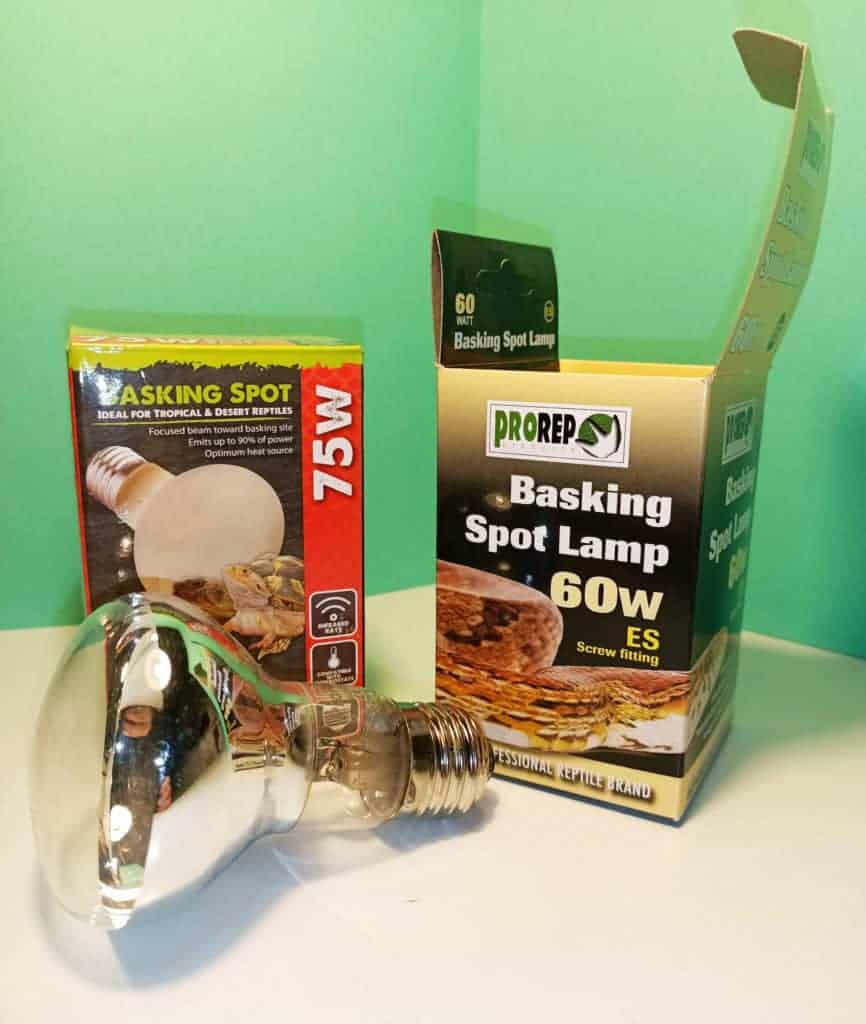
Heat bulbs are by far the most popular method, thanks in part to the fact that they are readily available at a range of different Wattages (power levels). The typical arrangement of a heat bulb is to have it suspended over the tortoise table/enclosure and fitted into a reflector dome. This is designed to contain and reflect the heat downward into the enclosure, therefore improving efficiency and maximising the amount of heat provided to the enclosure.
Some people like to suspend their heat bulb from a chain, or otherwise have it on a movable apparatus that allows its height to be adjusted, to vary the intensity of the heat. This is useful feature to have, but not strictly necessary, because the thermal gradient within the enclosure still gives the tortoise plenty of scope for adjusting his/her temperature regardless of the precise position of the heat bulb.
I have my heat bulb mounted about 6” (15cm) from the base of the enclosure, which effectively heats an area of around 6” diameter on the ground. This provides a good size basking spot for my juvenile Hermann’s, whilst not reducing the effectiveness of the thermal gradient.
From a safety perspective heat bulbs by their very nature get hot – (obviously!) So it’s important to limit the risk of fire, and the point at which this is likely to occur is the base fitting that the bulb screws into. Oftentimes light fittings screw into a plastic base, however there is the risk of this catching fire, so instead you should opt for a ceramic base fitting to mitigate the risk of fire considerably.
Ceramic Heat Emitters
If you already use but wish to try an alternative to a heat lamp, a ceramic heat emitter is a logical choice because they typically have the same screw fitting as a light bulb, meaning that one can easily be swapped out for the other.
The only thing to be careful of with this these devices is that they do not glow like a light bulb, therefore you won’t necessarily know if it is safe to the touch (ie switched on or off), so care is needed in this regard.
Lighting Requirements
Reptiles such as Hermann’s tortoises require exposure to sunlight on a daily basis in order to properly carry out a number of metabolic processes that are crucial for the tortoise to stay in good health. Failure to provide access to either good quality, unfiltered sunlight or an appropriate substitute light source on a long term basis can lead to your tortoise developing serious health issues.
Hermann’s tortoises require exposure to short wavelength light radiation in the ultraviolet range of the electromagnetic spectrum. More specifically, tortoises require two different wavelengths of UV light known as UVA and UVB, so it is important to choose light a bulb that will output both.
Without a sufficient dose of UV light tortoises natural behaviours and instincts will be compromised, and most worryingly of all, they will be unable to produce vitamin D, which in turn will prevent them from metabolising calcium which is essential for the healthy growth and development of the shell and skeleton.
Thanks to the wonders of evolution, sunlight contains the perfect blend of UV wavelengths required for a tortoise to stay healthy. There are a number of limiting factors that may prevent UV light bulbs from being as effective as sunlight, from brightness to the range of light wavelengths emitted. Indeed even the best light bulbs on the market can only achieve 90% of the range of colour that the sun provides.
None the less, there is little point in getting too bogged down with the actual physics of this, you should simply aim to provide a high quality light source that is stated as being suitable for tortoises with a color rendering index (CRI) of 90 or above, and that provides both UVA and UVB. This specification will provide lighting conditions as close to sunlight as It is possible to achieve.
Although there are light bulbs that meet this specification available in a variety of forms, the best choice are fluorescent tubes that span the entire length of the tortoise enclosure, because for obvious reasons, these provide a consistent dose of UV to the tortoise regardless of where in the enclosure they are located.
The only other consideration is to choose a bulb/fluorescent tube is also as bright as possible, again to try and mimic natural sunlight. Most UV lamps do a pretty good job of this, but it’s worth checking out none the less.
Both UV and heat lamps should be turned on for around 12 hours per day, but if you’re concerned about turning them on and off at the right times every day, it’s well worth investing in an electric timer so that you don’t have to think about it.
Check out our guide on arranging the lighting in your tortoise enclosure for further information.
Enclosure Substrate
The aim with any enclosure, whether indoors or outdoors, is to mimic the conditions that tortoises favor in the wild. In the case of the substrate (ground material) the trick is to choose a substance that is firm enough under foot for the tortoise to walk on comfortably, yet also pliable enough that the tortoise can dig, tunnel, and bury themselves should they wish to.
Most people choose a substance composed of soil and play sand, as this is soft enough to dig, and yet also maintains a degree of structural integrity when forming tunnels and channels that do not collapse. There are a number of other options however, and you can read about the pros and cons of each here.
You’ll want to make the substrate as deep as you can provide up to a depth of about 2’ (60cm), although clearly this isn’t at all practical for an indoor enclosure. Simply provide as much as you can to suit your enclosure, and bear in mind that it will require full replacement every month or so.
Owners who keep their tortoises outdoors prefer to keep their enclosures as natural as possible, simply making use of the soil already present in their yard. This can be perfectly acceptable if you have sandy, loam type soil in your part of the world, however dusty or clay rich soils will not be suitable.
Feeding
What you choose to feed your tortoise is of the upmost importance to ensuring they stay healthy, and failing to do so can lead to any number of debilitating ailments, from pyramiding to soft shell syndrome. Hermann’s tortoises are strictly herbivorous animals, meaning their diet should be entirely plant based.
In the past poor knowledge among keepers led to all kinds of misguided practices, such as feeding tortoises dog food and other high protein diets that are not at all conducive to good health.
In addition to feeding your tortoise the correct foods/supplements/water, you must also make sure to feed the right amounts, at the right times.
Some popular foods you will find growing in the wild or your back yard:
· Dandelion leaves and flowers (my personal go to plant of choice)
· Clover
· Flowers in the hibiscus family, including both the leaves and flowers
· Blackberry leaves and flowers (not thorns)
· Various grass species (although
Typically shop bought foods include:
· Kale
· Cress
· Cucumber
· Various salad leaves (not spinach)
· Bell peppers
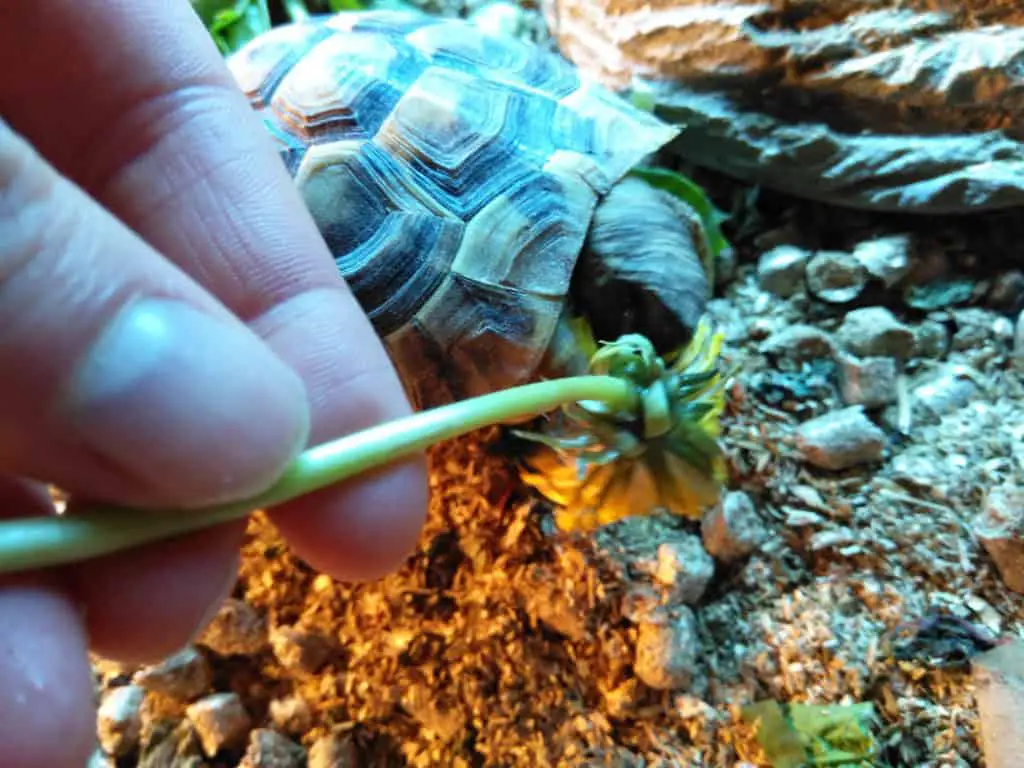
Fruits can also form part of your tortoises diet, however these should only be provided as an occasional treat due to the fact that excess sugar in the gut can provide the perfect breeding ground for various parasites to thrive. None the less, suitable fruits include:
· Melon
· Pear
· Apple
· Mango
For further information on what you can and cannot feed your tortoise check out our article on the subject here.
Feeding Frequency
Tortoises are generally pretty good at not over eating, especially given that the bulk of their diet is made up of fairly low calorie produce. Young tortoises in particular are unlikely to become overweight given that they are still growing, and as such you can feed them every day, as well as allowing them to graze and forage if they are kept in an outdoor enclosure.
Fully grown tortoises on the other hand do not require daily feeding in order to stay healthy, rather they can be fed twice per week and be allowed to graze for the rest of the time. This will be sufficient to maintain their bodyweight without issue.
Clearly if your tortoise has less space to roam then you will need to reduce the amount of food you provide due to less calories being burned and vice versa. By closely monitoring the weight of your tortoise over the course of a few months you should be able to get a feel for the optimum amount of food to provide, and gradually tailor this to meet their needs precisely.
Preparing Food
It’s good practice to wash any food (and leave it wet) prior to giving it to your tortoise, both to remove any excess dirt, and to provide an additional source of hydration. I prefer to place food on a small try within the enclosure to prevent too much stray food getting mixed up with the substrate, making life more difficult when cleaning up later on.
If you find it more manageable you can cut up leaves into very small pieces to make it easier for you tortoise to eat, however in general I have found this to be unnecessary unless the item is particularly unwieldy.
Supplementation
In addition to a varied plant based diet, you may well wish to supplement your tortoises diet with additional vitamins and minerals that make up for any deficiencies within their basic diet.
However you should understand that this is not simply a case of throwing a spoonful of multivitamin powder in with every feed, because the reality is that this can cause more problems than it solves, with overdosing on certain substances being a very real issue that can have a negative effect on your tortoise’s health.
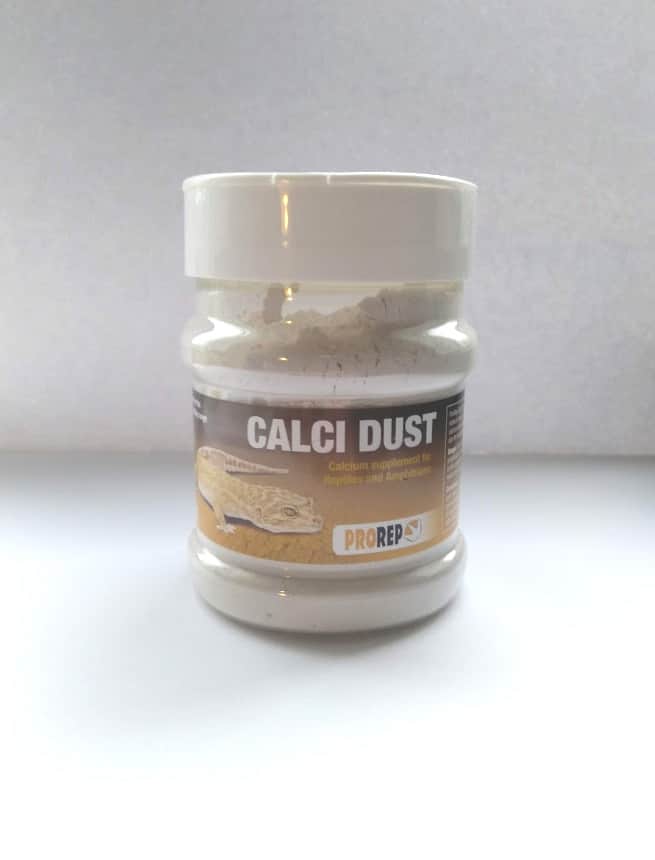
Pure calcium carbonate is widely regarded as a ‘safe’ means of providing the calcium supplementation that a tortoise needs, so I like to sprinkle some of this over my tortoise’s food several times per week. Indeed young, growing tortoises require more of this than fully mature specimens, so you can afford to be fairly liberal with it for the first few years of your tortoise’s life.
Multivitamins on the other hand need a lot more careful thought, and I would recommend discussing exactly what your tortoise’s needs will be based on their age and weight with your veterinary practitioner. As a general rule however, you probably won’t need to provide vitamin supplementation more than once per week.
Water
Like all life on Earth, water is absolutely essential for Hermann’s tortoises to both survive and thrive, therefore it is essential that your tortoise has access to a supply of water at all times.
I provide a shallow container about 3/4” (2cm) deep for my 3 year old Hermann’s tortoise for them to both drink from and, should they wish to, bathe in as well. It’s of critical importance that the water you provide isn’t deep enough that the tortoise could drown if they were to lose their footing when walking nearby.
You should replace your tortoise’s water on a daily basis, and thoroughly clean their water container as part of the same activity. This is particularly important if you have soaked the tortoise in the water and they have defecated in it. Leaving dirty water in place is a sure fire way to encourage the spread of pathogens and potential sickness.



